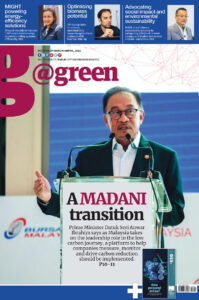Proper and successful implementation of carbon tax/ carbon pricing would lead to reducing carbon emissions
 By Dany Oon
By Dany OonIn the context of Green, it is undeniable that the environment plays a pivotal part in our daily lives. So far, the natural resources on Earth have arguably supplied not only human beings but also flora and fauna with the necessities that ensured the survival of all living forms on this planet – but the question remains: how sustainable would this be?
It is noted that much has been done by various parties, from social activists to governments, across the globe in terms of protecting Mother Nature and ensuring sustainability for the generations to come. But certainly, it has not yet drawn enough attention or effort from the overall human population on the matter. It is where, perhaps, tax can be used to regulate matters surrounding this simple yet essential aspect.
Tax – often can be perceived as a form of a stick, aiming to deter businesses from engaging in undesired activities. It usually goes hand-in-hand with the size of the stick, where heftier fines/ taxes will result in better compliance. On the other hand, tax may also play the role of the carrot, where incentives can be handed out to encourage businesses to partake in any activities aligned with national policies and strategies.
In the form of a stick, more developed and advanced countries such as Japan, Korea, Canada and the European Union have implemented carbon tax or carbon pricing where such tax is to be levied on emission-intensive goods or based on the rate of carbon emission. It is believed that with such additional “cost” of doing business, the eventual effort of Earth preservation will bear fruit. Malaysia too, who signed the Paris Agreement in 2015, has pledged to become carbon neutral by the year 2050. It recently revealed in Budget 2023 that it is studying the feasibility of implementing carbon tax/ carbon pricing soon.
Proper and successful implementation of carbon tax/ carbon pricing would lead to reducing carbon emissions. And even if not, at the very least it helps to create awareness on the importance of environment for all inhabitants on the planet. A suitable and balanced carbon tax framework on this aspect, with both stick and carrot elements, should help achieve the desired results for the economy and the environment. Amongst other things, we feel that the following aspects should be considered in designing the carbon tax framework:-
• The rate of carbon tax/ pricing
Tax rate is essential in determining whether the carbon tax regime is effective. Ideally, the bar should be set high enough to deter carbon emitters from continuing to use conventional fuel or energy but not too low so that businesses won’t feel the “pain” or even attempt to pass on the costs to consumers entirely. The tax rate can be monitored from time to time with alignment to the green policies on hand, signalling large emitters to switch to more energy-efficient options or relook at their production capacity and efficiency.
• Administration
A uniform carbon monitoring and reporting framework should be in place to ensure consistent measurement and accountability on the part of the taxpayers. To ensure the effectiveness of the carbon tax regime, adequate enforcement and clear guidelines/ legislation also need to be in place to prevent businesses from under-reporting their emissions. Although measuring carbon emissions may not be straightforward, there should not be complex or complicated compliance mechanisms. Otherwise, taxpayers may face challenges in reporting accordingly.
• Usage of collection
Although the carbon tax collection may be another revenue stream source for the government, this should not be the primary reason to have it as the objective should remain to be “de-carbonisation and resolve environmental issues”. Proper usage of the monies, such as reinvestment in developing green energy technology and sustainability efforts, would undoubtedly help advance the cause. Transparency and performance indicators should also be designed to measure and ensure the objectives are achieved.
• Incentives
As mentioned, carrot can also better induce the participation of businesses in the green agenda. There are only a handful of tax incentives available (e.g. Green Investment Tax Allowance, Green Income Tax Exemption, indirect tax exemption on electric vehicles, etc) which may not be attractive enough to entice businesses or individuals to cross over to the greener side. Perhaps the introduction of carbon credits, regardless of industry, and more extensive incentives/ governmental grants would serve the cause.
In anticipation of the inception of the carbon tax regime, businesses should assess their carbon footprint and identify relevant measures/ opportunities too. This could include preparing action plans to develop internal processes and controls for compliance, monitoring and reporting. Also, by developing new strategies and moving to energy-efficient technologies, businesses with sufficient foresight will have a competitive advantage if they plan and adapt ahead of their competitors. If the carbon tax framework is announced and implemented, this will give businesses a head start to implement a coordinated response to the new tax in a structured and efficient manner.
The highlights of harmful gas emissions, burning of fossil fuels, disposal of chemicals unlawfully, and the felling of trees are recipes for disasters which cause drastic climate change. And to name a few close to our hearts, the infamous water cuts due to pollution of rivers, massive flooding and landslides. These man-made disasters can surely be avoided altogether with proper governance and enforcement. Although there are currently fines and punitive measures, this does not seem to be severe enough to prevent the culprits who continuously engage in such irresponsible acts.
As many countries would agree, proper implementation of carbon tax/pricing would be significant in reducing one’s carbon footprint on planet Earth. Coupled with attractive environmental-related tax incentives, it encourages one to take “one small step for a man, one giant leap for mankind” (Louis Armstrong, 1969) as we strive to make Earth a better place for future generations.








